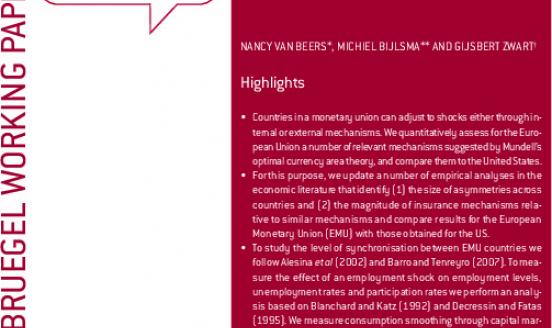Eurocrisis lessons from banking regulation: create collateral in return for support
The similarities between banks and countries in a monetary union are striking. First, like banks, countries in a monetary union can face a self-fulfil
The similarities between banks and countries in a monetary union are striking. First, like banks, countries in a monetary union can face a self-fulfilling run resulting in sudden stops. Second, just as one banks’ risk taking increases other banks’ probability of default because of contagion, as the current crisis in the eurozone shows, contagion is especially strong within a monetary union due to cross-border trade, impact on domestic banks, or investor beliefs on correlated risk (see e.g. the review in Pericoli and Sbracia, 2003). Third, just like banks considered to be sound turned to be insolvent in the 2007-2008 financial crisis, we are rediscovering that also in advanced economies debt levels can become unsustainable. And while a country with debt denominated in its own currency can not be forced into default by markets, this is not the case in a monetary union.
Bank regulation
It is therefore natural to compare bank regulation with the governance of countries in a monetary union. Bank regulation has basically three elements summarized in table 1 below: insurance against liquidity problems, regulation of risk taking incentives, and a framework to address solvency problems.
To prevent bank runs, all developed countries now have deposit insurance. For banks with immediate funding problems, there exists a lender of last resort (the ECB for eurozone bank). In addition, for too-big-to-fail banks there is an implicit bail-out guarantee. The presence of such safety nets, however, creates incentives for excessive risk taking. To mitigate these incentives we regulate banks by imposing capital requirements, leverage restrictions, and liquidity requirements. To address externalities across banks (i.e. systemic risk see e.g. here for a review of the literature) we are developing macroprudential regulation – although nobody is still quite sure what this exactly means or how it should be implemented. In spite of these precautions, banks can and do get in trouble. For that we need element number three: the ability to deal with solvency problems through a restructing framework that tries to balance recapitalisation, restructuring and bankruptcy. In the US, the FDICIA already provides such a framework. All these three elements have been expanded and are in the process of being modified substantially as a result of lessons drawn from the 2007-2009 financial crisis.
Countries in a monetary union
For countries in a monetary union the same three elements can be distinguished. To prevent interest rates from reaching unsustainable levels, eurozone countries are constructing mechanisms to insure against such shocks. The EFSF / ESM constitutes a rudimentary safety net with a limited firepower that tries to provide insurance to countries against liquidity and solvency shocks. In addition, the ECB has the powerful potential of performing open market operations and buying individual countries debt in the secondary market, in principle with the aim of ensuring the transmission of monetary policy. But it could also be used to protect countries from runs, although primary market intervention might be more efficient. Other currently non-existent instruments that prevent self-fulfilling runs on individual countries are also possible, such as eurobonds (which insure countries against runs but also shield their interest rates from macro-economic shocks or the consequences of bad policy decisions) and allowing the ECB to buy bonds in primary markets.
Where banks are regulated to reduce the risk of bankruptcy, countries in the EMU are increasingly regulated to prevent government debt from becoming unsustainable. The six-pack includes a ceiling on public debt, limits on the general government deficit, and monitoring of macroeconomic imbalances, while the European semester offers additional policy recommendations. The justifications are similar to those in the case of banks. First, insurance prevents runs on a country that impose negative externalities on other countries, while regulation aims to prevents moral hazard and free riding on other countries’ prudent policies.
Finally, when Greece restructured its debt through private sector involvement (PSI) it was the first western-European country to default since the second world war. We are rediscovering that countries in a monetary union can go bankrupt. How can we deal with countries facing solvency problems (unsustainable debt levels)? Like banks, they can be recapitalized. Countries can be bailed out with the aid of other countries. The ESM / EFSF can be and has been used to do this, although under the assumption that loans would be fully paid back. In addition, countries may adjust through internal devaluation (i.e. a downward nominal adjustment in domestic wages and prices ) or fiscal devaluation, restructuring of private or public debt (the latter has been done through PSI in Greece while the former may be awaiting us for Spanish banks), or even restore exchange rate mechanisms by exiting the monetary union (this requires exit from the monetary union). Table 1 below summarizes this analogy between banks and countries in a monetary union.
Table 1: Similarities
|
|
Regulation |
Safety net |
Solvency problems |
| Banks |
|
|
|
|
|
|
|
|
|
Countries in a monetary union |
|
|
|
Differences
Of course, there are important differences, summarized in table 2. The first difference concerns the enforceability of regulation. Banking regulators can withdraw a bank’s banking licence. It has the legal power to force banks to increase capital and take other measures. How might the European Commission enforce the six-pack? Access to structural funds can be withheld, countries can be excluded from negotiations, voting rights on ECB can be withdrawn (theoretically, as this is not possible under the current treaty), and fines may be imposed. But although there is some scope for disciplining measures, there is no analogy to the withdrawal of banking licenses.
A related issue is the independence of the regulator. Where a banking regulator is independent, countries in a monetary union in essence regulate themselves. This may be effective if there are ways for countries to commit themselves to certain rules. In a monetary union, however, rules and regulation are never set in stone and can always be renegotiated. This undermines the effectiveness of regulating countries debt levels, unless sovereignty is truly transferred to a supranational level.
Concerning the safety net, a central difference between countries and banks is the possibility for banks to post collateral. Banks that receive insurance in the form of liquidity support are required to pledge collateral. This is an important device to solve problems arising from asymmetric information. It insures the lender against moral hazard and can be used to separate good risks from bad risks. In contrast, it is difficult for countries to pledge collateral in return for support, as this would require committing to hand over future tax receipts or national resources. This point is well-known from the literature on sovereign debt, see e.g. Panizza, Sturzenegger and Zettelmeyer, who argue that creditors have limited recourse to government assets because ‘few sovereign assets (including future income streams) are located in foreign jurisdictions, and a sovereign cannot credibly commit to hand over assets within its borders in the event of a default. Second, there are legal principles that protect sovereign assets even when they are located in foreign jurisdictions.’
The final difference is in the possibility to address solvency problems. Outsiders can not recapitalise a country in return for an equity stake. In addition, sovereign countries can not be forced to enter into a program with the EFSF / ESM and relinquish control in return for bail-out loans. This latter difference is, however, smaller than it may seem, because in the 2007-2008 crisis some banks also resisted nationalisation.
Table 2: Differences
|
Regulation |
Safety net |
Solvency |
|
|
|
Lessons
What lessons can we draw from this comparison? Eurozone countries are trying to stop an evolving liquidity and solvency crisis without resorting to all-out liquidity support, while at the same time limiting transfers and ruling out further integration as a way to improve control over policy and budgets. This is close to trying to regulate countries in the way we regulate banks. Important limitations of this approach lie in the ability to enforce regulation and to obtain collateral in return for liquidity or solvency support. Regarding the former, it might be possible to enhance the effectiveness of ex ante regulation by devising ways to better discipline individual countries. A more systematic approach would be possible that combines hard measures like withdrawal of structural funds, imposing monetary fines, and soft measures like imposing non-monetary institutional restriction (i.e. withholding voting right on certain topics).
More importantly, it may be feasible to strengthen the possibilities to give other countries some form of collateral in return for loans in order to facilitate liquidity provision and some form of recapitalisation of weak countries by healthy ones. This would help to solve the prisoners-dilemma that surplus and deficit countries seem to be stuck in right now. One possibility is to set-up semi-private funds that use public assets allocated by the government as backing obtain support from other eurozone countries. According the Financial Times, Italy is considering taking that route to try and obtain funds from private parties, but it could equally well serve as collateral for support from other eurozone countries. Imagine the ESM obtaining the effective rights to revenue flows from airports, railroads, or energy networks. A second possibility is to strengthen the legal possibilities of enforcing claims on collateral offered by eurozone governments. Europe has developed a common law system with supranational jurisdiction by the European Court of Justice, which might prove valuable in this respect.

